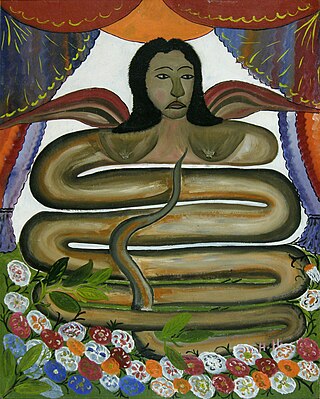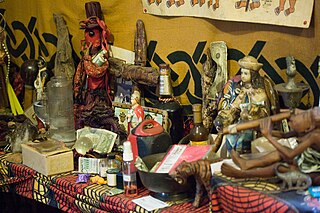Related Research Articles

Lwa, also called loa or loi, are spirits in the African diasporic religion of Haitian Vodou. They have also been incorporated into some revivalist forms of Louisiana Voodoo. Many of the lwa derive their identities in part from deities venerated in the traditional religions of West Africa, especially those of the Fon and Yoruba.

Rastafari, sometimes called Rastafarianism, is a religion that developed in Jamaica during the 1930s. It is classified as both a new religious movement and a social movement by scholars of religion. There is no central authority in control of the movement and much diversity exists among practitioners, who are known as Rastafari, Rastafarians, or Rastas.
Riddim is a Jamaican Patois Jamaican genre of music that emanated from the English word "rhythm". In the context of dancehall, it refers to the instrumental accompaniment to a song and is synonymous with the rhythm section. Jamaican music genres that use the term consist of the riddim plus the voicing sung by the deejay. The resulting song structure is distinctive in many ways. A given riddim, if popular, may be used in dozens—or even hundreds—of songs, not only in recordings but also in live performances.

African diaspora religions, also described as Afro-American religions, are a number of related beliefs that developed in the Americas in various nations of the Caribbean, Latin America and the Southern United States. They derive from traditional African religions with some influence from other religious traditions, notably Christianity and Islam.
Obeah, or Obayi, is a series of African diasporic spell-casting and healing traditions found in the former British colonies of the Caribbean. These traditions derive much from traditional West African practices that have undergone cultural creolization. There is much regional variation in the practice of Obeah, which is followed by practitioners called Obeahmen and Obeahwomen.
Palo, also known as Las Reglas de Congo, is an African diasporic religion that developed in Cuba during the late 19th or early 20th century. It arose through a process of syncretism between the traditional Kongo religion of Central Africa, the Roman Catholic branch of Christianity, and Spiritism. Initiates in the religion are termed paleros (male) or paleras (female).
Grounation Day is an important Rastafari holy day, second only to Coronation Day. It is celebrated in honour of Haile Selassie's 1966 visit to Jamaica.
Tambor is a coastal Afro-Venezuelan music and dance. It is a cultural manifestation originating in the slaves from Africa. The drums are of Kongo origin, as are most musical genres of Afro-Venezuelan origin. The Tambores are done with the playing of a cumaco which is a long cylinder-shaped drum played on the ground while the player sits on it and plays. It also consists of drums known as campanas which are played by sitting down in a chair and playing them with the hands. These drums are often used for religious ceremonies. In the Afro-Catholic community, it is used to honour and invoke San Juan or some other Saint. In the Maria Lionza context, the drums are used to invoke the spirits to possess the materia or medium as well as to animate the spirit and give it force.

Haitian Vodou is an African diasporic religion that developed in Haiti between the 16th and 19th centuries. It arose through a process of syncretism between several traditional religions of West and Central Africa and Roman Catholicism. There is no central authority in control of the religion and much diversity exists among practitioners, who are known as Vodouists, Vodouisants, or Serviteurs.

Espiritismo is a term used in Latin America and the Caribbean to refer to the popular belief that evolved and less evolved spirits can affect health, luck and other aspects of human life.
Vodou drumming and associated ceremonies are folk ritual faith system of henotheistic religion of Haitian Vodou originated and inextricable part of Haitian culture.

Santería, also known as Regla de Ocha, Regla Lucumí, or Lucumí, is an African diasporic religion that developed in Cuba during the late 19th century. It arose through a process of syncretism between the traditional Yoruba religion of West Africa, the Catholic form of Christianity, and Spiritism. There is no central authority in control of Santería and much diversity exists among practitioners, who are known as creyentes ("believers").
Nyabinghi, is the gathering of Rastafari people to celebrate and commemorate key dates significant to Rastafari throughout the year. It is essentially an opportunity for the Rastafari to congregate and engage in praise and worship. For example, on July 23 of each year, a Nyabinghi is held to celebrate the birth of Emperor Haille Selassie I. During a Nyabinghi celebration men and women have different roles and expectations. Men are expected to remove any hair coverings, whilst women must keep their hair covered. A group of men typically organise themselves in a line or semi-circle and are assigned to beat the drums throughout. The remaining congregation continue to sing well known songs or 'chants', some of which are Hebraic scriptural verses that evidence the divinity of Haile Sellassie. For example, 'I have a little light in I and I'm going to make it shine, Rastafariiii, shine' and 'Holy Mount Zion is a holy place and no sinners can enter there, so let the words of my mouth and the mediation of my heart, be acceptable in thy sight, of Rastafari'. Nyabinghi is a Rastafari tradition that promotes Rastafari unity, strengthens the Rastafari spirit with fellowship and raises the consciousness and presence of Rastafafari in the heart of those in attendance. At some points passages of the bible are read. Rastafari recognise the significance of Jesus Christ, due to Haile Sellassie I fulfilling the teachings and prophecy of scripture.
Nyabinghi or Nyabingi is a legendary woman in the culture of Rwanda, Uganda and Tanzania, where religions or 'possession cults' formed around her.

Myal is an Afro-Jamaican spirituality. It developed via the creolization of African religions during the slave era in Jamaica. It incorporates ritualistic magic, spiritual possession and dancing. Unlike Obeah, its practices focus more on the connection of spirits with humans. Over time, Myal began to meld with Christian practices and created the religious tradition known as Revivalism.
Convince, also known as Bongo or Flenke, is a religion from eastern Jamaica. It has roots in Kumina and Jamaican Maroon religion.
In the Cuban religion of Santería, omiero, also known as purificacíon de santo, is a liquid used in various ritual acts.
In the Caribbean religion of Santería, individuals are required to go through an initiation process to become a full practitioner, known as a santero (male) or santera (female).
The Rastafari movement developed out of the legacy of the Atlantic slave trade, in which over ten million Africans were enslaved and transported to the Americas between the 16th and 19th centuries. Once there, they were sold to European planters and forced to work on the plantations. Around a third of these transported Africans were relocated in the Caribbean, with under 700,000 being settled in Jamaica. In 1834, slavery in Jamaica was abolished after the British government passed the Slavery Abolition Act 1833. Racial prejudice nevertheless remained prevalent across Jamaican society. The overwhelming majority of Jamaica's legislative council was white throughout the 19th century, and those of African descent were treated as second-class citizens.
Santería is an Afro-Cuban religion that arose in the 19th century.
References
Citations
- ↑ Stewart, Dianne M. (2005-07-07). Three Eyes for the Journey: African Dimensions of the Jamaican Religious Experience. Oxford University Press. ISBN 9780198039082.
- ↑ Murrell, Nathaniel Samuel (2010-01-25). Afro-Caribbean Religions: An Introduction to Their Historical, Cultural, and Sacred Traditions. Temple University Press. ISBN 9781439901755.
- 1 2 Ryman, Cheryl (2014). "Kumina". In Horn, David; Shepherd, John (eds.). Bloomsbury Encyclopedia of Popular Music of the World, Volume 9: Genres: Caribbean and Latin America. Bloomsbury Publishing. ISBN 9781441132253.
- 1 2 3 4 5 6 Fernández Olmos & Paravisini-Gebert 2011, p. 178.
- ↑ Davy (2018). "Kumina in Rural Southeastern Jamaica: Beyond Resistance to Antithetical-Hegemonic-Subsumption" (PDF). Journal of Pan African Studies. 11 (7). Retrieved 29 September 2023.
- ↑ "Kumina Queen's Drum Repatriated To Jamaica". Jamaican Gleaner. 3 August 2014. Retrieved 5 December 2016.
- ↑ Edmonds 2012, p. 55.
Sources
- Edmonds, Ennis B. (2012). Rastafari: A Very Short Introduction. Oxford: Oxford University Press. ISBN 978-0199584529.
- Fernández Olmos, Margarite; Paravisini-Gebert, Lizabeth (2011). Creole Religions of the Caribbean: An Introduction from Vodou and Santería to Obeah and Espiritismo (second ed.). New York and London: New York University Press. ISBN 978-0-8147-6228-8.